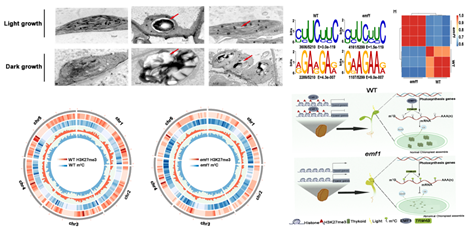Recently, Dr. Li Pu’s group from Biotechnology Research Institute, Chinese Academy of Agricultural Sciences, revealed a genome-wide correlation between RNA 5-cytosine methylation (m5C) and histone 3 lysine27 trimethylation (H3K27me3) to regulate chromatin state and gene transcription required for vigorous vegetative growth in Arabidopsis, which establishes for the first time a link between m5C and dynamic chromatin modification and provides mechanistic insight into the co-transcriptional interplay between RNA modifications and histone modifications in plants. The work,entitled “RNA 5-methylcytosine modification regulates vegetative development associated with H3K27 trimethylation in Arabidopsis”, was published online in AdvancedScienceon November16th, 2022.
Plant development progresses through distinct phases: embryo development, seedling germination, vegetative growth, followed by a flower development and eventually seed set and senescence. The transitions between these phases are controlled by distinct genetic circuits that integrate endogenous and environmental cues. However, how the different epigenetic mechanisms are integrated and coordinated in each developmental phase is so far unknown. In this study, the scientistsrevealed a genome-wide reverse correlation between histone modification H3K27me3 and RNA methylation m5C.The plant-specific PcG protein EMF1 acts to not only repress flower, seed and starch genes through PcG-mediated repressive histone mark H3K27me3 (EMF1-PcG-H3K27me3), but alsoactivate expression of chloroplast and photosynthesis genes via m5C methyltransferase TRM4B-meidated RNA methylation (EMF1-TRM4B-m5C).The opposite regulation of gene expression of diverse gene programs is both required for vigorous vegetative growth in Arabidopsis. These findings provide a novel epigenetic mechanism involved in histone modification and RNA m5C methylation and therefore adds another layer of complexity for gene regulation in eukaryotes.

The graduate students Daolei Zhang, Weijun Guo (PhD) and Postdoc Ting Wang contributed equally to this work. This work was supported by the National Natural Science Foundation of China (31872805), the National Key Research and Development Program of China (2021YFF1000301), the Fundamental Research Funds for Central Non-Profit of Chinese Academy of Agricultural Sciences (CAAS-ZDRW202109), the Innovation Program of Chinese Academy of Agricultural Sciences (CAAS-ZDRW202004) and Nanfan special project of Chinese Academy of Agricultural Sciences (YBXM15).
More details can be found at the link: https://doi.org/10.1002/advs.202204885 |